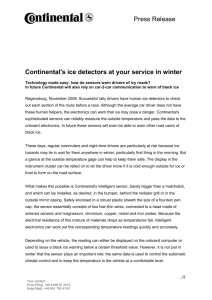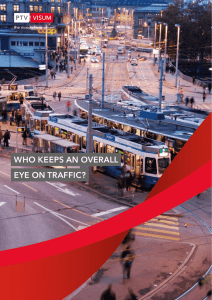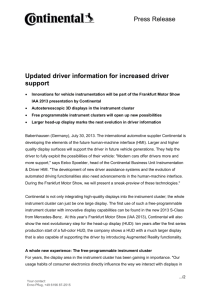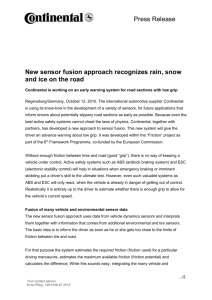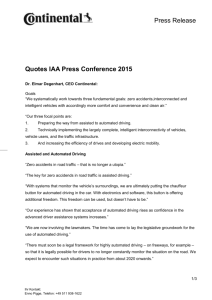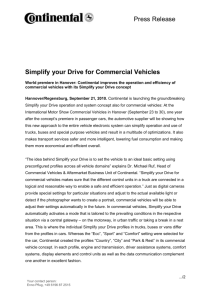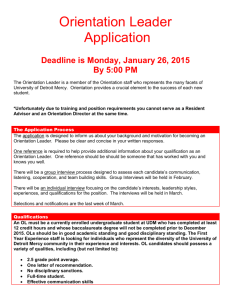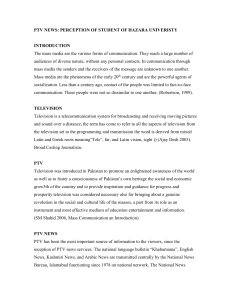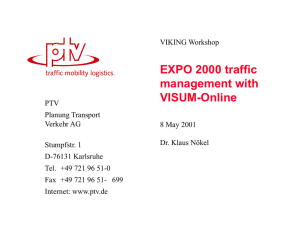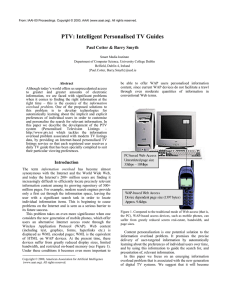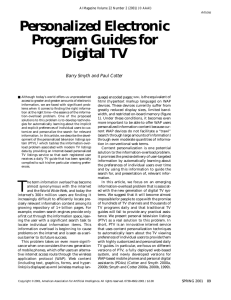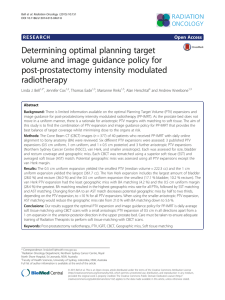Press Release
advertisement
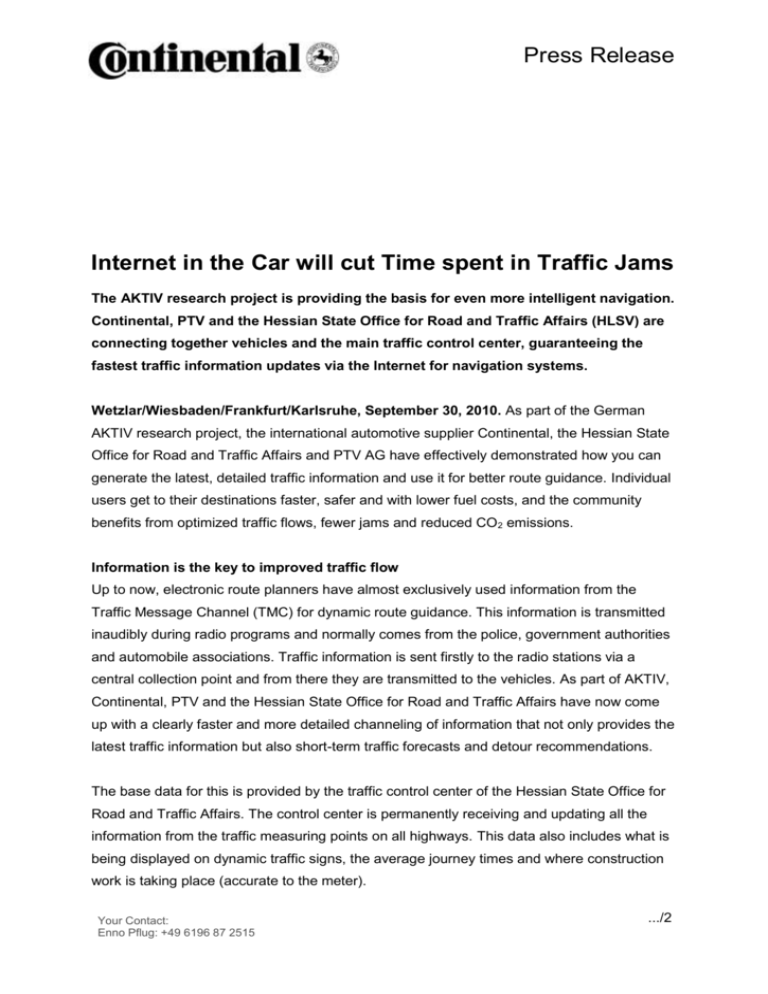
Press Release -1- Internet in the Car will cut Time spent in Traffic Jams The AKTIV research project is providing the basis for even more intelligent navigation. Continental, PTV and the Hessian State Office for Road and Traffic Affairs (HLSV) are connecting together vehicles and the main traffic control center, guaranteeing the fastest traffic information updates via the Internet for navigation systems. Wetzlar/Wiesbaden/Frankfurt/Karlsruhe, September 30, 2010. As part of the German AKTIV research project, the international automotive supplier Continental, the Hessian State Office for Road and Traffic Affairs and PTV AG have effectively demonstrated how you can generate the latest, detailed traffic information and use it for better route guidance. Individual users get to their destinations faster, safer and with lower fuel costs, and the community benefits from optimized traffic flows, fewer jams and reduced CO2 emissions. Information is the key to improved traffic flow Up to now, electronic route planners have almost exclusively used information from the Traffic Message Channel (TMC) for dynamic route guidance. This information is transmitted inaudibly during radio programs and normally comes from the police, government authorities and automobile associations. Traffic information is sent firstly to the radio stations via a central collection point and from there they are transmitted to the vehicles. As part of AKTIV, Continental, PTV and the Hessian State Office for Road and Traffic Affairs have now come up with a clearly faster and more detailed channeling of information that not only provides the latest traffic information but also short-term traffic forecasts and detour recommendations. The base data for this is provided by the traffic control center of the Hessian State Office for Road and Traffic Affairs. The control center is permanently receiving and updating all the information from the traffic measuring points on all highways. This data also includes what is being displayed on dynamic traffic signs, the average journey times and where construction work is taking place (accurate to the meter). Your Contact: Enno Pflug: +49 6196 87 2515 .../2 -2- This data is transmitted online to PTV's information platform and is automatically analyzed there. Apart from providing details of the latest traffic situation, this platform also gives traffic forecasts every 15 minutes for each individual section of the journey giving a prognosis of up to the next two hours. The necessary base data for these forecasts as well as for the information covering the entire area is provided by the PTV Validate traffic model. This is how the system knows not only where the jams are at the moment, but also where the situation can improve or get worse within the next few hours. For drivers on long journeys, this is important in planning the rest of their route. Whereas up to now, the TMC data was received via the car radio, the AKTIV development partners send more up-to-date and more precise traffic information as TPEG data (Transport Protocol Experts Group, an open standard for sending traffic and travel information) via cellular radio signals to the navigation system. The vehicle's navigation system accesses a new Internet service to receive this data making it possible to call up information minute by minute as needed, depending on network coverage. Results from the tests show that on average ten times more traffic information can be generated using this AKTIV technology than was previously the norm, and it can be integrated into the navigation's route planning. Due to the increase in the amount of data, it was also possible to greatly improve the quality of the services. In addition to the extra information such as current average driving speeds for individual sections of roads, information on traffic congestion is also transmitted by the minute, pin-pointing the affected areas to the meter. With the help of this much improved base data, the online forecasts and the detour recommendations from the traffic control center, Continental's navigation systems can further optimize route guidance and at the same time help reduce existing traffic congestion and prevent new jams from developing on the detour roads. For drivers, this means time standing in traffic is reduced to a minimum and fuel consumption is less. Stress, being pressed for time, and dangerous driving maneuvers, possibly as a result of those factors, are a thing of the past. A relaxed drive and a faster, safer journey are literally "preprogrammed". And for the community, the AKTIV technology enables existing road capacity to be used much more effectively, thus keeping Your Contact: Enno Pflug: +49 6196 87 2515 .../3 -3traffic congestion down to a minimum. After all, the best way to avoid dangerous tail ends of traffic jams is not to allow them in the first place. Now that the system’s functional capability has been proven in the research project, the participating companies have begun working on its mass scale launch. The developers can see this system being in regular use as soon as 2013. PTV AG Corporate Communications Kristina Stifter Stumpfstr. 1 76131 Karlsruhe, Germany Tel.: +49 721 9651-565 kristina.stifter@ptv.de www.ptv.de Enno Pflug External Communications Continental Interior Division Sodener Straße 9 65824 Schwalbach am Taunus, Germany Tel.: +49 6196 87-2515 Fax: +49 6196 8779-2515 enno.pflug@continental-corporation.com www.aktiv-online.org Your Contact: Enno Pflug: +49 6196 87 2515 Hessian State Office for Road and Traffic Affairs Christa Tserdakidou Strategy and Communication Wilhelmstraße 10 65185 Wiesbaden, Germany Tel.: +49 611 366 – 3032 christa.tserdakidou@hsvv.hessen.de www.verkehr.hessen.de www.staufreieshessen2015.de
